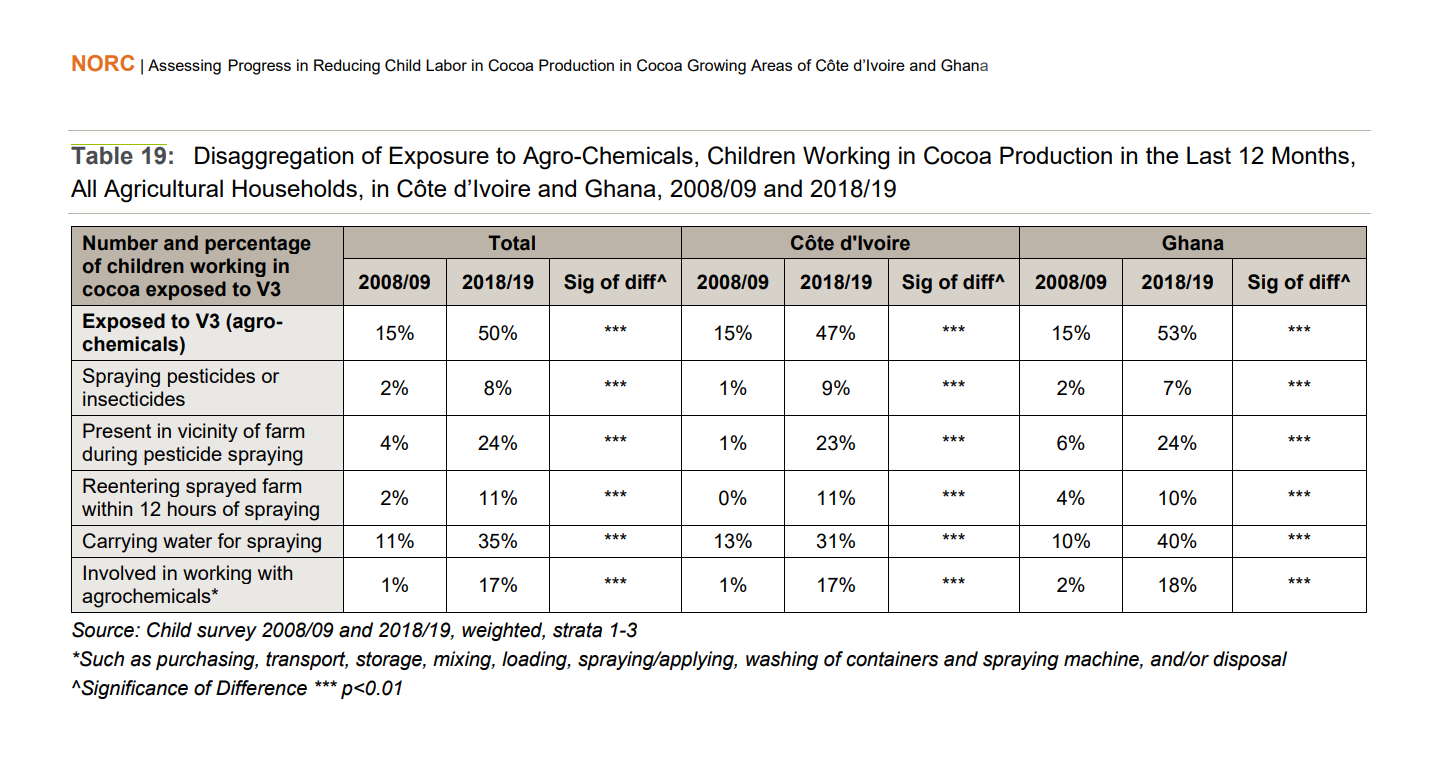At Halloween, we want our costumes to be scary, not our chocolate. But underneath the wrappers of many chocolate bars is cocoa coming from pods doused in pesticides. That is bad for us and even worse for the people who grow cocoa.
Large chocolate companies do not want you to know what goes into making cocoa. That is why Green America has been providing consumers with an annual Chocolate Scorecard for almost 10 years. It is an effective tool for civil society organizations to hold chocolate companies accountable for their supply chain management and sustainability goals. And it gives consumers an ethical guide when navigating an opaque shopping experience. We want to help all those chocoholics out there to choose ethical chocolate more easily!
For the first time this year, the chocolate scorecard included a new category: Agrichemical Management.
There are many reasons why.
Agrichemicals in Chocolate
Ghana and Côte d’Ivoire, where over two-thirds of the world’s cocoa come from, have seen a steady rise in pesticide use, as have other cocoa-producing countries like Indonesia. This trend is not surprising, since low- and middle-income countries (LMIC) with weak regulations are often treated as a lucrative market for unscrupulous exporters of highly hazardous pesticides (HHPs). At this rate, agrichemicals in chocolate are common, and spreading fast.
Banned or unapproved pesticides are regularly exported from high-income to LMIC, in particular Africa and Central America. The United States, the second largest exporter of pesticides, legally permits U.S. companies to export pesticides that are not even approved or registered-for-use in the U.S. under the 1947 statue, the Federal Insecticide, Fungicide and Rodenticide Act (FIFRA).
In Ghana and Côte d’Ivoire where tens and thousands of small-scale cocoa farming households continue to make around $1 per day per person (well below the poverty line of $2.15 USD), many farmers are incentivized to use pesticides without proper information or personal protective equipment (PPE). Impoverished farmers are often desperate for higher yields and pesticides create that in the short term, since cocoa is highly vulnerable to pests and diseases when cultivated as a monocrop.
Effects of Pesticides on Women and Children
To make matters worse, poverty and the lack of access to public education have driven many farming households to rely on child labor. A 2020 report found that over 1.5 million children engage in cocoa production in West Africa. According to the same study, children have been exposed to agrichemicals at an increasing trend from 5% in 2008 to 24% in 2019. Children handle hazardous pesticides and other agrichemicals when they engage in spraying, transporting, storing, mixing, and cleaning machines used for dispensing pesticides. Children and pregnant women are particularly susceptible to harm from pesticide exposure. Those who handle pesticides, as well as those in the surrounding community, can suffer from acute poisoning to serious chronic health issues. In fact, many chemicals used on cocoa farms around the world are not even allowed for use in the United States or EU countries because they pose alarming and well-documented health risks. In addition, pesticides often pollute soil and water, further harming human health. Many farmers rely on streams or wells for washing and drinking water that have been contaminated. Few have access to piped-in and treated water.

Dangers of Pesticides to Our Planet
The vicious cycle of pesticide use is not costless to consumers thousands of miles away. The global trend of agrichemical use in cocoa is contributing to:
- Pollinator collapse and risk of extinction
- Catastrophic biodiversity collapse
- Toxic pollution of soil and water
- Microplastics that persist in the environment and in our bodies, according to a recent report exposing deliberate use of microplastics in synthetic pesticides and fertilizers
Standing Up Against Toxic Pesticides in Chocolate
Green America and its allies are calling on the chocolate industry to address the use of toxic pesticides in cocoa production. Industry needs to get serious about the problem, and foot the bill for a much needed and urgent reform. Chocolate is projected to be a 180 billion USD industry by 2025, thriving despite the COVID-19 pandemic. We cannot ask impoverished cocoa farmers, many of whom experienced a decrease in their income during the pandemic, to shoulder the burden of transitioning from hazardous pesticides to sustainable and soil-nourishing practices.
Recently, the German NGO INKOTA, and the VOICE Network, a global network of NGOs and trade unions working on sustainability in cocoa, co-hosted a webinar “Harmful Impacts, Little Action: Pesticides in Cocoa Production in West Africa” calling on a transition to safer pesticide alternatives.
The groups behind the Chocolate Scorecard, including Green America, began asking major chocolate companies two years ago to transition away from highly hazardous pesticides, and to ensure the transition was farmer centric. This year the companies were ranked publicly for the first time.
Here are some of the questions companies were asked and graded on:
- Does the company have lists of active substances that it monitors, prohibits, or restricts throughout its supply chain?
- In the last two years, have any active substances been added to or deleted from the company’s monitored, prohibited, or restricted list?
- How does the company support farmers to reduce chemical use?
- How does the company support farmers in adopting non-chemical alternatives to pesticides?
- What percentage of your volume is certified organic?
- How is the company ensuring that children and pregnant women are not exposed to pesticides?
The scorecard found that many companies, including Mondelez and Lindt, need to do significant work to address pesticides. At the bottom of the pack, General Mills and Starbucks refused to share anything about what they are doing to address environmental and social harms of their cocoa, including pesticides.

Check out the chocolate scorecard to see how the companies rank.
Etelle Higonnet, leading activist in cocoa industry reforms, shared: “It is absolutely possible to do better cocoa – that is pesticide-free, that uses biochar and compost instead of fertilizers that are chemical, and that is good for forest, good for wildlife, good for human health.”
Let us all commit to better cocoa.
What You Can Do to Fight Pesticides in Your Chocolate
As consumers we can drive change in the industry. Consumer pressure has gotten some of the largest chocolate companies to take action.
Take action today by:
- Take Action: Tell the EPA to ban dangerous organophosphates
- Acting on social media: Send a message to major chocolate companies that they need to address farmer poverty, child labor and pesticide in their cocoa.
- Buying from the heart: Purchase chocolates from companies that are leaders in protecting farmers, communities, and the environment. To eliminate pesticide from cocoa, the best you can buy is organic chocolate. Second best is to purchase chocolates that are certified by FairTrade or Rainforest Alliance.
- Telling your friends: Message your friends and family on Halloween, share this blog with them, and let them know about how they can help treat – not trick – both people and planet!






